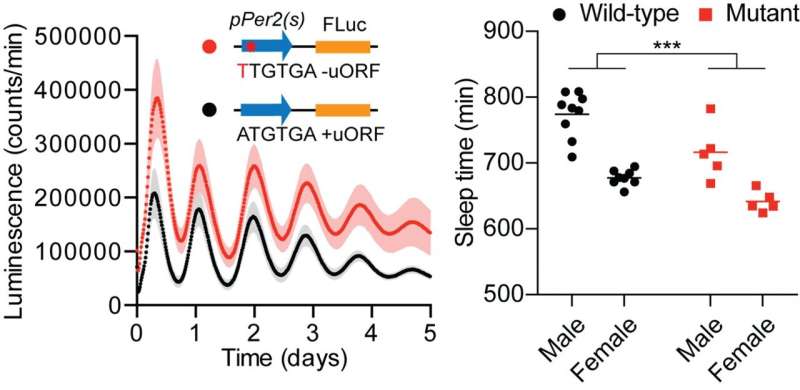This article has been reviewed according to Science X's editorial process and policies. Editors have highlighted the following attributes while ensuring the content's credibility:
fact-checked
peer-reviewed publication
trusted source
proofread
Researchers identify structure in circadian mRNA that affects the sleep-wake cycle

Circadian rhythms, the internal biological clocks that regulate our daily activities, are essential for maintaining health and well-being. While the role of transcription in these rhythms is well-established, a new study sheds light on the critical importance of post-transcriptional processes.
The research, titled "Circadian ribosome profiling reveals a role for the Period2 upstream open reading frame in sleep," published in PNAS, redefines our understanding of how translation and post-transcriptional processes influence the body's internal clock and its impact on sleep patterns.
Timing is everything
By using ribosome profiling, the research team examined the timing of ribosome binding in relation to peak protein and RNA levels. They discovered significant differences in the timing of these processes, suggesting a complex post-translational control of circadian protein production.
"We built upon our previous work to precisely quantify the level of circadian proteins in mice held in constant darkness over a 24-hour period, which controls for the confounding effects of light," says corresponding author Hiroki Ueda.
"Using ribosome profiling, I wanted to see how the binding of ribosomes to RNA related to the timing of when those proteins actually got made. And by trying to answer this basic timing question, we found that ribosomes bind an upstream open reading frame in Period2 which altered the amplitude of circadian rhythms and disrupted sleep in mice," adds lead author Arthur Millius.
uORFs: Silent regulators speak out
The researchers found many upstream open reading frames (uORFs) in the 5' untranslated region of circadian mRNAs, which is the part of RNA before the so-called "coding sequence" that gets translated by ribosomes into protein. These uORFs were associated with reduced ribosome binding in the main coding sequence and reduced reporter expression in a variety of circadian assays tested by the researchers suggesting a role for uORFs in shaping circadian protein expression.
"About half of genes in mice and humans have at least one uORF," explains Dimitri Perrin, the team's bioinformatician, "but it's particularly interesting that about 75% of genes associated with circadian rhythms have an uORF, which means that circadian rhythms are particularly susceptible to this type of post-transcriptional regulation."
Per2 uORF mutation and sleep
Mutating the uORF in the core clock gene Period2 (Per2) yielded intriguing results. It boosted Per2 mRNA expression while significantly reducing total sleep duration in mice, particularly during transitions between light and dark.
"Our sleep data suggests that disrupting uORFs can have physiological impacts on mice behavior, which shows that you don't have to mutate the protein to have an effect," explains Rikuhiro Yamada who analyzed the phenotype of the mice using the lab's snappy sleep stager system.
"We performed ribosome profiling on the Per2 uORF mutant mice, and although ribosome binding was enhanced in the mutant mice, it was the increase in Per2 mRNA levels that was the most surprising," continues Arthur Millius. "We thought uORFs would primarily affect mRNA translation, but it turns out they might also trigger an RNA degradation response similar to nonsense mediated decay."
PER2 protein is at the center of the inhibitory feedback loop that underlies the molecular mechanisms that control circadian rhythms, but its importance goes beyond just regulating sleep.
Per2 expression is deregulated in breast cancer, downregulated in patients with acute myeloid leukemia, and disruption of Per2 results in tumorgenesis in mice. Therefore, understanding the post-transcriptional processes that shape Per2 expression has wide-ranging implications for the various fields, including circadian rhythms and medicine, and could provide new insights into how cancer hijacks a cell's normal circadian program or help improve drugs with time-dependent therapeutic efficacy.
More information: Arthur Millius et al, Circadian ribosome profiling reveals a role for the Period2 upstream open reading frame in sleep, Proceedings of the National Academy of Sciences (2023). DOI: 10.1073/pnas.2214636120


















